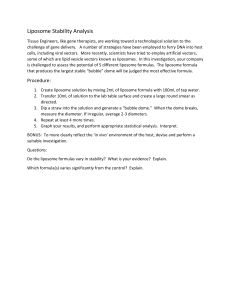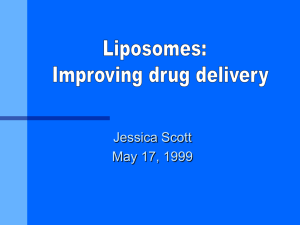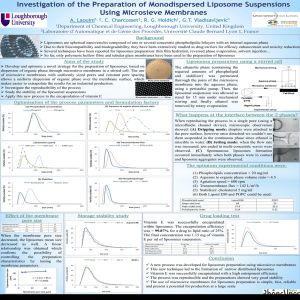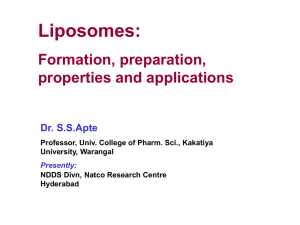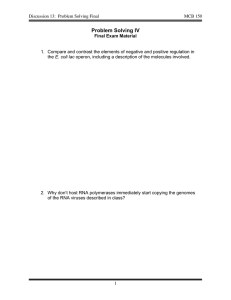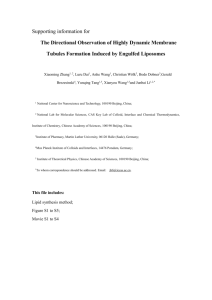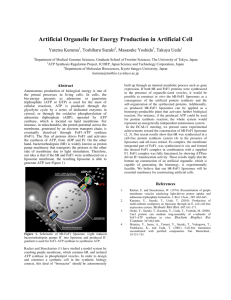Document 13309894
advertisement
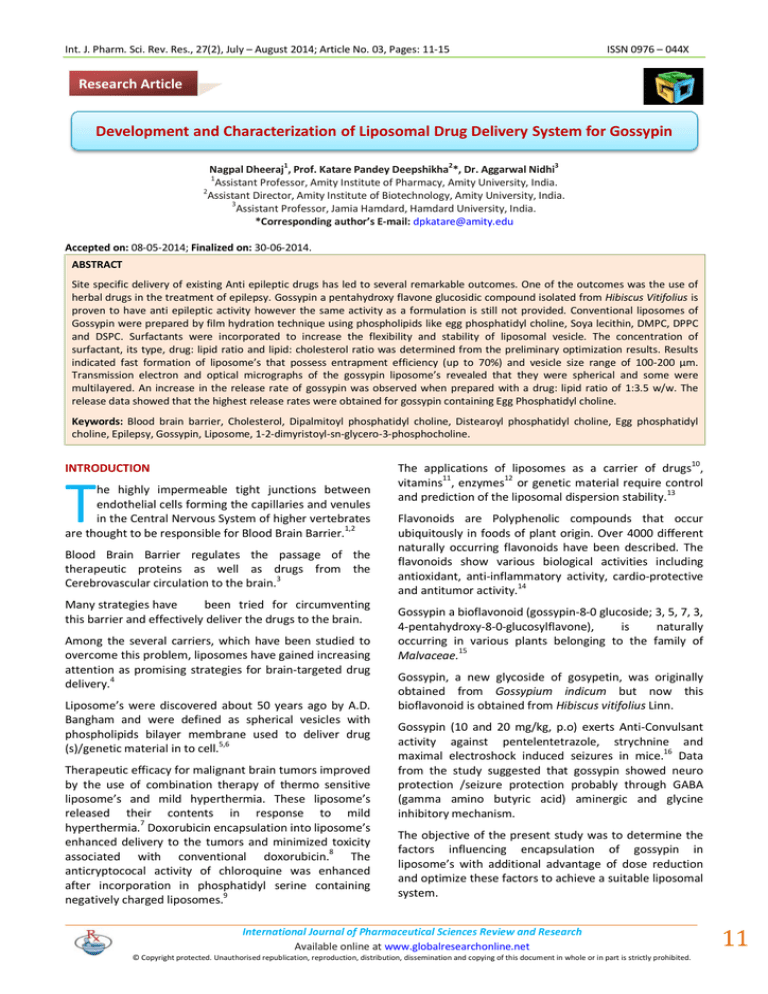
Int. J. Pharm. Sci. Rev. Res., 27(2), July – August 2014; Article No. 03, Pages: 11-15
ISSN 0976 – 044X
Research Article
Development and Characterization of Liposomal Drug Delivery System for Gossypin
1
2
3
Nagpal Dheeraj , Prof. Katare Pandey Deepshikha *, Dr. Aggarwal Nidhi
1
Assistant Professor, Amity Institute of Pharmacy, Amity University, India.
2
Assistant Director, Amity Institute of Biotechnology, Amity University, India.
3
Assistant Professor, Jamia Hamdard, Hamdard University, India.
*Corresponding author’s E-mail: dpkatare@amity.edu
Accepted on: 08-05-2014; Finalized on: 30-06-2014.
ABSTRACT
Site specific delivery of existing Anti epileptic drugs has led to several remarkable outcomes. One of the outcomes was the use of
herbal drugs in the treatment of epilepsy. Gossypin a pentahydroxy flavone glucosidic compound isolated from Hibiscus Vitifolius is
proven to have anti epileptic activity however the same activity as a formulation is still not provided. Conventional liposomes of
Gossypin were prepared by film hydration technique using phospholipids like egg phosphatidyl choline, Soya lecithin, DMPC, DPPC
and DSPC. Surfactants were incorporated to increase the flexibility and stability of liposomal vesicle. The concentration of
surfactant, its type, drug: lipid ratio and lipid: cholesterol ratio was determined from the preliminary optimization results. Results
indicated fast formation of liposome’s that possess entrapment efficiency (up to 70%) and vesicle size range of 100-200 µm.
Transmission electron and optical micrographs of the gossypin liposome’s revealed that they were spherical and some were
multilayered. An increase in the release rate of gossypin was observed when prepared with a drug: lipid ratio of 1:3.5 w/w. The
release data showed that the highest release rates were obtained for gossypin containing Egg Phosphatidyl choline.
Keywords: Blood brain barrier, Cholesterol, Dipalmitoyl phosphatidyl choline, Distearoyl phosphatidyl choline, Egg phosphatidyl
choline, Epilepsy, Gossypin, Liposome, 1-2-dimyristoyl-sn-glycero-3-phosphocholine.
INTRODUCTION
T
he highly impermeable tight junctions between
endothelial cells forming the capillaries and venules
in the Central Nervous System of higher vertebrates
are thought to be responsible for Blood Brain Barrier.1,2
Blood Brain Barrier regulates the passage of the
therapeutic proteins as well as drugs from the
Cerebrovascular circulation to the brain.3
Many strategies have
been tried for circumventing
this barrier and effectively deliver the drugs to the brain.
Among the several carriers, which have been studied to
overcome this problem, liposomes have gained increasing
attention as promising strategies for brain-targeted drug
delivery.4
Liposome’s were discovered about 50 years ago by A.D.
Bangham and were defined as spherical vesicles with
phospholipids bilayer membrane used to deliver drug
(s)/genetic material in to cell.5,6
Therapeutic efficacy for malignant brain tumors improved
by the use of combination therapy of thermo sensitive
liposome’s and mild hyperthermia. These liposome’s
released their contents in response to mild
7
hyperthermia. Doxorubicin encapsulation into liposome’s
enhanced delivery to the tumors and minimized toxicity
8
associated with conventional doxorubicin.
The
anticryptococal activity of chloroquine was enhanced
after incorporation in phosphatidyl serine containing
negatively charged liposomes.9
The applications of liposomes as a carrier of drugs10,
vitamins11, enzymes12 or genetic material require control
and prediction of the liposomal dispersion stability.13
Flavonoids are Polyphenolic compounds that occur
ubiquitously in foods of plant origin. Over 4000 different
naturally occurring flavonoids have been described. The
flavonoids show various biological activities including
antioxidant, anti-inflammatory activity, cardio-protective
and antitumor activity.14
Gossypin a bioflavonoid (gossypin-8-0 glucoside; 3, 5, 7, 3,
4-pentahydroxy-8-0-glucosylflavone),
is
naturally
occurring in various plants belonging to the family of
Malvaceae.15
Gossypin, a new glycoside of gosypetin, was originally
obtained from Gossypium indicum but now this
bioflavonoid is obtained from Hibiscus vitifolius Linn.
Gossypin (10 and 20 mg/kg, p.o) exerts Anti-Convulsant
activity against pentelentetrazole, strychnine and
maximal electroshock induced seizures in mice.16 Data
from the study suggested that gossypin showed neuro
protection /seizure protection probably through GABA
(gamma amino butyric acid) aminergic and glycine
inhibitory mechanism.
The objective of the present study was to determine the
factors influencing encapsulation of gossypin in
liposome’s with additional advantage of dose reduction
and optimize these factors to achieve a suitable liposomal
system.
International Journal of Pharmaceutical Sciences Review and Research
Available online at www.globalresearchonline.net
© Copyright protected. Unauthorised republication, reproduction, distribution, dissemination and copying of this document in whole or in part is strictly prohibited.
11
© Copyright pro
Int. J. Pharm. Sci. Rev. Res., 27(2), July – August 2014; Article No. 03, Pages: 11-15
ISSN 0976 – 044X
20
MATERIALS AND METHODS
Encapsulation efficiency
Materials
Ultracentrifugation method was used to determine the
encapsulation efficiency. In this method 1 mL of the
liposomal suspension was subjected to centrifugation at
8000 rpm for 30 minutes at room temperature. Later the
supernatant and sediment (concentrate) were collected
and diluted with methanol. Lysis of liposomes was
achieved with methanol and vortexing for 5 minutes.
From the obtained clear solution concentration of
gossypin was determined spectrophotometrically at a χ
max 280 nm using empty lysed liposomes.
Gossypin was purchased from M/S Chromadex (USA), L-αEgg Phosphatidyl choline (EPCL), 1-2-dimyristoyl-snglycero-3-phosphocholine (DMPC), 1-2-distearoyl-snglycero-3-phosphocholine (DSPC) and Dipalmitoyl
phosphatidyl choline (DPPC) were purchased from Sigma
Chemicals. All other reagents and chemicals were of
analytical grade.
Preparative Methods
Formulas for preparing liposomes were optimized by
“model independent optimization method”. Parameters
that have significant effect on entrapment efficiency and
in-vitro drug release were selected to investigate and they
were (a) lipid: cholesterol ratio (Table 1), (b) surfactant
concentration (Table 2).
The concentration of lipid, type and concentration of
surfactant, lipid: cholesterol ratio, to be used was fixed
based on the optimization results.
The liposome’s were prepared accordingly and evaluated
for entrapment efficiency and in-vitro drug release (Table
3).
Briefly, the desired amounts of lipid and cholesterol were
weighed (including drug) in to 50 mL pear shaped flask
and 4 mL of chloroform and methanol mixture (1:1) was
added to dissolve lipids.
Organic solvent mixture was then removed under vacuum
conditions using rotary evaporator at 60°C for 30 minutes,
after which the flask was kept under vacuum overnight to
completely remove any residual solvent. Encapsulation of
Gossypin in to liposome’s was accomplished by the
addition of pH 7.4 phosphate buffer saline (PBS)
containing 2 % Poloxamer P188. Dry lipids were hydrated
with PBS.
Reduction of Liposome Size17
Liposomal vesicle size was reduced by subjecting to
sonication for 60 minutes. Sonication causes the
breakdown of larger vesicles.2
Physicochemical Characterization
18
Microscopic studies
Vesicle morphology of the prepared liposome’s with
different molar ratios of phospholipids and cholesterol
was determined using a photomicroscope.
Mean Particle size analysis18
Particle size and size distribution of liposomes were
measured by the photon correlation spectroscopy (PCS,
Zetasizer Nano S 90 Malvern, England)
TEM19
The TEM of the optimized formulation showed uniform
spherical appearance of the liposomes.
In-vitro release
Gossypin release from the liposomal formulation was
evaluated using dialysis method proposed by Xu et’al.
Briefly, 500 µl of liposomal suspension was taken in to an
eppendorf tube assembly and then immersed in 40 mL of
release medium (pH 7.4 PBS) while stirring the release
medium using a magnetic stirrer, samples (1mL) were
collected and replaced with same amount of fresh
medium at predetermined time intervals over a 72 hrs
period.
At the end of 24 hrs, 40 ml of release medium containing
0.5% Triton X100 and SDS was added to the previous one
and 500 µl of the same was added to the liposomal
sample in the tube. The collected samples were diluted
suitably and concentration determined.
The release data of the final optimized formulation EPCL
was subjected to Kinetic analysis (Figure 5).
RESULTS AND DISCUSSION
Optimization of formula
Selection of lipid: Cholesterol ratio
Five formulations (SLC 01 – SLC 05) were prepared having
different lipid: Cholesterol concentrations (Table I) in
order to optimize for highest drug entrapment and invitro drug release. It was found that formulation SLC 02
with a lipid: cholesterol concentration of 55:45 mM
showed highest entrapment efficiency (87.09 %) and invitro drug release (87.27%) when compared to other
concentrations.
Selection of surfactant
Surfactants like Tween 80, Sodium lauryl Sulphate and
Poloxamer 188 were used in the concentration range of
0.025%-0.25% (Table 2). A significant increase in
entrapment efficiency was observed with increase in
Poloxamer 188 concentration from 0.025% to 0.2 %. The
same was not observed with Tween 80 and Span 80.
Improper correlation was observed in case of Tween 80
and Span 80.
Preparation of Gossypin containing liposome
Based on the above optimization results 55:45 lipid:
cholesterol ratio was fixed as it showed highest in-vitro
release and entrapment efficiency (Table 1 Formulation
International Journal of Pharmaceutical Sciences Review and Research
Available online at www.globalresearchonline.net
© Copyright protected. Unauthorised republication, reproduction, distribution, dissemination and copying of this document in whole or in part is strictly prohibited.
12
© Copyright pro
Int. J. Pharm. Sci. Rev. Res., 27(2), July – August 2014; Article No. 03, Pages: 11-15
SLC02). Poloxamer at a concentration of 0.2% was
selected for further studies (Table 2 Formulation SLP4).
ISSN 0976 – 044X
phosphatidyl choline (EPCL), 1-2-dimyristoyl-sn-glycero-3phosphocholine (MPCL) and were evaluated for
entrapment efficiency and in-vitro drug release
Composition of final liposomal formulations and their %
EE and drug release
Formulation EPCL (Table 3) containing egg phosphatidyl
choline showed highest entrapment efficiency of 89.29 %
and an in-vitro drug release of 83.441 %
Gosssypin containing liposome’s were prepared using
different phospholipids viz. dipalmitoyl phosphatidyl
choline (PPCL), distearoyl phosphatidyl choline (SPCL), Egg
EPCL was selected as the final optimized formulation.
Table 1: Effect of Lipid: cholesterol ratio on % Entrapment efficiency and drug release
Formulation Code
Lipid:Cholesterol conc. (mM)
{Soya lecithin : cholesterol}
Drug (mg)
P188 conc. % w/v
%EE
In-Vitro drug release
SLC01
50:50
10
0.2
82.11
88.72
SLC02
55:45
10
0.2
87.09
87.27
SLC03
60:40
10
0.2
55.59
47.42
SLC04
65:35
10
0.2
60.61
50.85
SLC05
70:30
10
0.2
32.31
51.20
Table 2: Selection of Surfactant (SLT with Tween 80, SLS with Sodiun Lauryl Sulphate, SLP with Poloxamer 188 as
surfactant)
Formulation
Surfactant
Conc.(% w/v)
Drug (mg)
Phospholipid (mg)
[Soya Lecithin}
Cholesterol (mg)
%EE
In-Vitro drug release
SLT1
0.025
10
37.28
17.40
99.29
54.10
SLT2
0.05
10
37.28
17.40
92.38
64.07
SLT3
0.1
10
37.28
17.40
95.89
85.50
SLT4
0.2
10
37.28
17.40
70.66
70.45
SLS1
0.025
10
37.28
17.40
41.04
92.44
SLS2
0.05
10
37.28
17.40
58.71
90.35
SLS3
0.1
10
37.28
17.40
41.04
85.43
SLS4
0.2
10
37.28
17.40
34.33
83.30
SLP1
0.025
10
37.28
17.40
91.03
83.56
SLP2
0.05
10
37.28
17.40
59.47
94.66
SLP3
0.1
10
37.28
17.40
89.23
90.39
SLP4
0.2
10
37.28
17.40
98.52
85.01
Table 3: Final liposomal compositions
Formulation
Drug (mg)
Phospholipid (mg)
Cholesterol (mg)
P 188 Conc. (% w/v)
%EE
In-Vitro drug release
EPCL
10
41.80
17.40
0.2
89.29
83.41
MPCL
10
37.28
17.40
0.2
42.06
54.37
PPCL
10
40.37
17.40
0.2
98.48
64.80
SPCL
10
43.45
17.40
0.2
82.45
60.00
SLL
10
37.28
17.40
0.2
98.68
66.96
Characterization of Liposome’s
Table 4: Vesicle size of final liposomal compositions
Vesicle Size
Size of the drug loaded liposomes was carried out using
Master sizer 2000 (Table 4).
Formulation EPCL showed a vesicle size of 104.35 nm
(Figure 1).
Formulation
Vesicle Size (radius in nm)
EPCL
104.35
MPCL
172.16
PPCL
28.33
SLL
33.00
International Journal of Pharmaceutical Sciences Review and Research
Available online at www.globalresearchonline.net
© Copyright protected. Unauthorised republication, reproduction, distribution, dissemination and copying of this document in whole or in part is strictly prohibited.
13
© Copyright pro
Int. J. Pharm. Sci. Rev. Res., 27(2), July – August 2014; Article No. 03, Pages: 11-15
ISSN 0976 – 044X
To mimic this in in-vitro, surfactants like Triton X -100 and
2 % SDS was added to both the liposomal sample and also
the release medium.
The final Optimized EPCL formulation showed 83.41 %
drug release at the end of 72 hrs and other formulations
viz. MPCL, PPCL, SPCL & SLL showed 54.77, 64.80, 60 & 61
% drug release at the end of 72 hrs (Figure 4).
Figure 1: Vesicle Size for EPCL
Vesicle Shape
Vesicle Shape of the liposomes was analyzed by optical
microscopy. Pictures of liposome’s (Figure 2) were taken
at a magnification of above 44 times by Nikon camera.
The Liposome’s were spherical and bilamellar in case of
EPCL.
Figure 4: Drug Release profile of liposomal formulations
The TEM of EPCL formulation also showed the presence
of spherical particles (Figure 3).
Figure 2: Microscopic picture of formulation EPCL
Figure 5: Best fit kinetic model for EPCL
CONCLUSION
The work mainly dealt with the development of gossypin
liposomes. The liposome’s, with synthetic and/ naturally
derived phospholipids as the major component (55 mole
%) was applied.
Figure 3: TEM picture of formulation EPCL
In-Vitro Drug release studies
For assessing the drug release from the prepared
liposomal formulations, a two stage dialysis method was
followed, as proposed by Xu et’al.
First stage was for 24 hrs in which it was postulated that
the drug release in this stage was only due to free drug.
Also this stage mimics that before reaching the target site
liposomes circulate in the blood for 24 hrs. Whereas in
stage second, it was postulated that liposome’s reach the
target site by 24 hrs and therefore the drug release after
24 hrs must be taken in to consideration. The drug
release after 24 hrs was determined as the actual drug
released from the liposomes at the target site (Figure 4).
In summary, In-Vitro dialysis experiments showed that
cholesterol (45mloe %) and 0.2 % surfactant
incorporation lead to increased gossypin release from
liposome’s and higher drug-to-lipid ratio 1:3:6 resulted in
faster release. The Improved therapeutic index of
gossypin and drugs similar to gossypin are anticipated to
be achieved with application of liposomal drug delivery
system
Acknowledgement: Authors are highly thankful to Dr
Vandita Kakkar, University Institute of Pharmaceutical
Sciences, Panjab University, Chandigarh, India to provide
facilities during research work.
REFERENCES
1.
Reese TS, Karnovsky MJ, Junctions between intimately
apposed cell membranes in vertebrate brain, J Cell Biol., 34,
1967, 207-217.
International Journal of Pharmaceutical Sciences Review and Research
Available online at www.globalresearchonline.net
© Copyright protected. Unauthorised republication, reproduction, distribution, dissemination and copying of this document in whole or in part is strictly prohibited.
14
© Copyright pro
Int. J. Pharm. Sci. Rev. Res., 27(2), July – August 2014; Article No. 03, Pages: 11-15
ISSN 0976 – 044X
2.
Nagy Z, Peters H, Heuttner I, Mechanisms of edema
formation in experimental autoimmune encephalomyelitis.
The contribution of inflammatory cells, J Lab Invest., 50,
1984, 313-322.
12. Mahesh N, Varsha B, Development of vitamin loaded
topical liposomal formulation using factorial design
approach, Drug Deposition and stability, International
Journal of Pharmaceutics, 320, 2006, 37-44.
3.
Begley DJ, Delivery of Therapeutic agents to the central
nervous systems: the problems and possibilities, Pharmacol
Ther., 104(1), 2004, 29-45.
13. Gomez H, Analytical methods for the control of liposomal
delivery systems, Trends in Analytical Chemistry, 25, 2006,
2.
4.
Lai F, Fadda AM’ Sinico C, Liposomes for brain delivery,
Expert Opin Drug Delivery, 10(7), 2013, 1003-1022.
5.
Sultana Y, Liposomal Drug Delivery Systems: An Update
Review, Current Drug Delivery, 41, 2007, 297-305.
14. Babu BH, Jayaram HN, Nair MG, Ajay Kumar KB, Padikkala J,
Free radical scavenging, antitumor and anti-carcinogenic
activity of gossypin, J Exp Clin Cancer Res, 6, 2003, 2281-89.
6.
Sharma S, Sharma N, Gupta S, Liposomes: A Review,
Journal of Pharmacy research, 2(7), 2009, 1163-1167.
7.
Akoi H, Kakinuma K, Morita K, Kato M, Uzuka T, Igor G,
Takahashi H, and Tanaka R, Therapeutic efficacy of
targeting chemotherapy using local hyperthermia and
thermo sensitive liposome: evaluation of drug distribution
in a rat glioma model, Int. J. Hyperthermia, 20(6), 2004,
595-605.
8.
9.
Vail DM, Amantea MA, Colbern GT, Martin FJ, Hilger RA,
Pegylated liposomal doxorubicin: proof of principle using
preclinical animal models and pharmacokinetic studies, 31
(6 Suppl. 13), 2004, 16-35.
Khan MA, Jabeen R, Nasti TH, Mohammad O, Enhanced
anticryptococcal
activity
of
chloroquine
in
phoaphatidylserine-containing liposomes in a murine
model, J. Antimicrobial Chemother, 55 (2), 2005, 223-228.
10. Gregoriadis G, Liposomes as drug carriers: Recent Trends
and progress, John Wiley and sons, New York, 1988, 663677.
11. Lian T, Trends and Development in liposome drug delivery
systems, J Pharm Sci., 90, 2001, 667-680.
15. Vidyasagar J, Srinivas M, Nagulu M, Venkatasam A,
Udyakiran B, Krishna DR, Protein binding study of gossypin
by equilibrium dialysis, Curr Trends Biotech Phar, 2, 2008,
396-401.
16. Rasilingam D, Duraisamy S, Subramanian R, Anticonvulsant
activity of bioflavonoid gossypin, Bangladesh J Pharmacol,
4, 2009, 51-54.
17. Xu X, Khan M, Burgess DJ, A Two Stage reverse dialysis invitro dissolution testing method for passive targeted
liposomes, International Journal of Pharmaceutics, 426,
2012, 211-8.
18. Pilaslak A, Preparation and evaluation of liposomes
containing clove oil, Silpakorn University Master Thesis,
2008.
19. Roozi B, AFM, ESEM, TEM and CLSM in liposomal
characterization: A comparative study, International
Journal of nanomedicine, 6, 2011, 557-563.
20. Elmoslemany R, Abdallah OY, Khalafallah NM, Propylene
glycol liposomes as a topical delivery system for
Miconazole nitrate: Comparison with conventional
liposomes, AAPS PharmSci Tech, 13, 2012, 723-731.
Source of Support: Nil, Conflict of Interest: None.
International Journal of Pharmaceutical Sciences Review and Research
Available online at www.globalresearchonline.net
© Copyright protected. Unauthorised republication, reproduction, distribution, dissemination and copying of this document in whole or in part is strictly prohibited.
15
© Copyright pro
